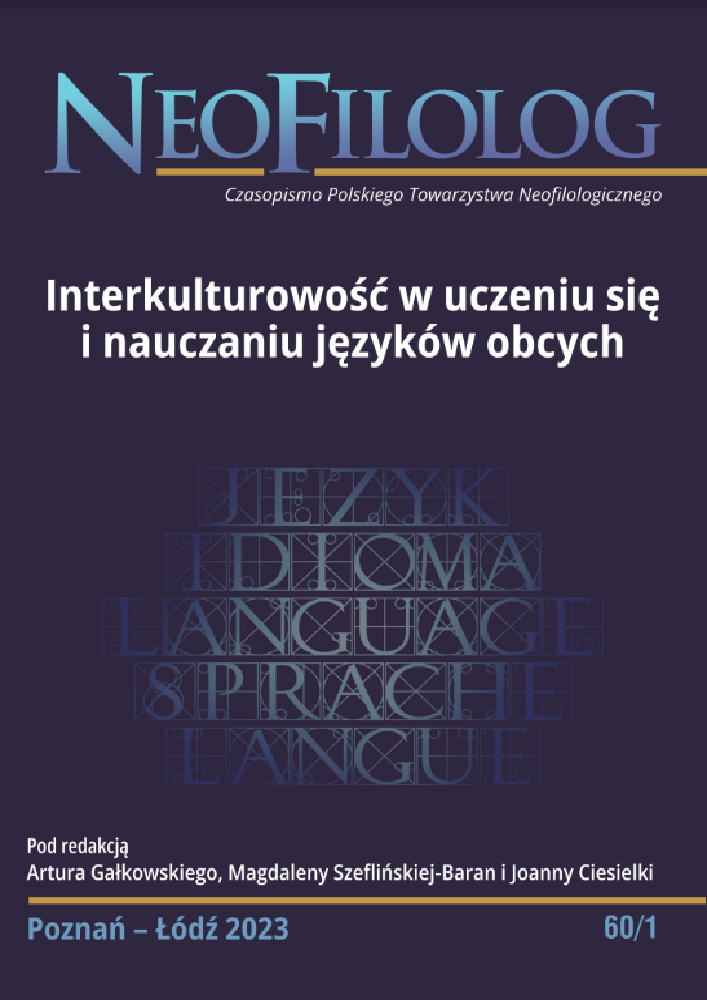Abstract
This study explores the link between language and culture in the context of translating specialist texts. The starting point is the assumption that each text contains a cultural element, even if it is “only” a professional text. The illustration of the theoretical considerations is a comparative analysis of translations (from French into Polish) of press articles in the field of economics. The analysis of selected press materials shows that their cultural value is not a peripheral phenomenon, but constitutes an important sense-creating element. In the process of their translation, the translator's tasks include not only changing the original linguistic structures, but also changing the cultural perspective embedded in the text. The carriers of the cultural point of view are both single lexical units, as well as linguistic constructions and complex conceptual networks. Based on the research, the authors conclude that it seems particularly important to sensitize students to respect the genre standards of the target language and to understand the need to reconceptualize the original conceptual metaphor and change the deictic perspective of the text.
Literaturhinweise
Anusiewicz J., Nieckula F. (red.) (1992), Język a kultura, tom 5. Potoczność w języku i kulturze. Wrocław: Wydawnictwo Wiedza o Kulturze.
Barańczak S. (1992), Ocalone w tłumaczeniu: szkice o warsztacie tłumacza poezji z dodatkiem Małej antologii przekładów-problemów. Kraków: Wydawnictwo „a5”.
Bartmiński J. (red.) (1999), Językowy obraz świata. Lublin: Wydawnictwo UMCS.
Bartmiński J., Tokarski R. (1993), Definicja semantyczna: czego i dla kogo?, (w:) Bartmiński J., Tokarski R. (red.), O definicjach i definiowaniu. Lublin: Wydawnictwo UMCS, s. 47-61.
Bogdanowicz E. (2017), Konotacje nazw własnych (na materiale publicystyki prasowej). Białystok: Wydawnictwo Uniwersytetu w Białymstoku.
Hejwowski K. (2004), Kognitywno-komunikacyjna teoria przekładu. Warszawa: PWN.
Jakobson R. (1960), Poetyka w świetle językoznawstwa. „Pamiętnik Literacki”, nr 51/2, 1960, s. 431-473.
Lakoff G., Johnson M. (2010), Metafory w naszym życiu. Warszawa: Wydawnictwo Aletheia.
Lewandowska-Tomaszczyk B. (2010), Nowe spojrzenie na przekład: podobieństwo, granice ekwiwalencji i rekonceptualizacja. „Lingwistyka Stosowana”, nr 3, s. 9-31.
Marcjanik M. (2007), Grzeczność w komunikacji językowej. Warszawa: PWN.
Paprocka N. (2005), Problemy klasyfikacji błędów w przekładzie. Studenckie tłumaczenia tekstów użytkowych z francuskiego na polski, (w:) Piotrowska M. (red.), Język trzeciego tysiąclecia III. Konteksty przekładowe. Kraków: Tertium, s. 417-428.
Piotrowski S., Sadowska-Dobrowolska K. (2020), Tłumaczenie pisemne na język polski: o spójności tekstu docelowego. „Roczniki Humanistyczne”, t. LXVIII, s. 89-102. DOI: https://doi.org/10.18290/rh206810-7
Płużyczka M. (2010), Bezekwiwalentność a kontekst kulturowy, (w:) Grucza S., Marchwiński A., Płużyczka M. (red.), Translatoryka. Koncepcje – modele – analizy. Warszawa: Uniwersytet Warszawski, s. 387-399.
Shank R.C., Abelson R.P. (1977), Scripts, Plans, Goals and Understanding. An Inquiry Into Human Knowledge Structures. London: Routledge.
Tabakowska E. (2010), Wyznaczniki literackości w przekładzie tekstów „nieliterackich”, (w:) Grucza S., Marchwiński A., Płużyczka M. (red.), Translatoryka. Koncepcje – modele – analizy. Warszawa: Uniwersytet Warszawski, s. 144-155.
Tokarski R. (1988), Konotacja jako składnik treści słowa, (w:) Bartmiński J. (red.), Konotacja. Lublin: Wydawnictwo UMCS, s. 35-54.
Tokarski R. (2001), Słownictwo jako interpretacja świata, (w:) Bartmiński J. (red.), Współczesny język polski. Lublin: Wydawnictwo UMCS, s. 343-370.
Urbanek D. (2010), Tłumaczenie jako komunikacja interkulturowa, (w:) Grucza S., Marchwiński A., Płużyczka M. (red.), Translatoryka. Koncepcje – modele – analizy. Warszawa: Uniwersytet Warszawski, s. 156-163.
Walasek H. (2004), Polski język unijny (eurożargon) jako nowa odmiana języka polskiego, (w:) Dąbrowska A. (red.), Wrocławska dyskusja o języku polskim jako obcym. Wrocław: Wydawnictwo WTN, s. 263-268.
Wojtak M. (2004), Gatunki prasowe. Lublin: Wydawnictwo UMCS.
Zarzycka G. (2004), Linguakultura – czym jest, jak ją badać i „otwierać”?, (w:) Dąbrowska A. (red.), Wrocławska dyskusja o języku polskim jako obcym. Wrocław: Wydawnictwo WTN, s. 435-443.
Lizenz
Copyright (c) 2023 Piotrowski Sebastian, Katarzyna Sadowska-Dobrowolska

Dieses Werk steht unter der Lizenz Creative Commons Namensnennung - Keine Bearbeitungen 4.0 International.
Autoren:
Die Autoren der zur Veröffentlichung in der Zeitschrift Neofilolog angenommenen Texte sind verpflichtet, den Vertrag über die Erteilung einer kostenlosen Lizenz für die Werke mit der Verpflichtung zur Erteilung einer Sublizenz CC auszufüllen, zu unterzeichnen und an die Adresse der Redaktion zurückzusenden.
Gemäß Vertrag erteilen die Autoren auf die in der Zeitschrift Neofilolog veröffentlichten Texte der Adam-Mickiewicz-Universität in Poznań eine nicht exklusive und kostenlose Lizenz und erlauben die Verwendung der Sublizenz Creative Commons Attribution-NoDerivatives 4.0 International (CC BY-ND 4.0).
Die Autoren behalten das Recht zur weiteren freien Verfügung über das Werk.
Benutzer:
Interessierte Onlinebenutzer dürfen die seit 2017 veröffentlichten Werke unter folgenden Bedingungen nutzen:
- Anerkennung der Urheberschaft - die Verpflichtung, zusammen mit dem verbreiteten Werk Informationen über die Urheberschaft, den Titel, die Quelle (Links zum Originalwerk, DOI) und die Lizenz selbst bereitzustellen;
- ohne Schaffung abgeleiteter Werke - das Werk muss in seiner ursprünglichen Form erhalten bleiben, ohne Zustimmung des Autors dürfen keine Studien, beispielsweise Übersetzungen, verbreitet werden.
Die Urheberrechte aller veröffentlichen Texte sind vorbehalten.
Sonstige:
Die Adam-Mickiewicz-Universität in Poznań behält das Recht auf die Zeitschrift als Gesamtheit (Layout, Grafik, Titel, Umschlagsprojekt, Logo usw.).

